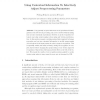Free Online Productivity Tools
i2Speak
i2Symbol
i2OCR
iTex2Img
iWeb2Print
iWeb2Shot
i2Type
iPdf2Split
iPdf2Merge
i2Bopomofo
i2Arabic
i2Style
i2Image
i2PDF
iLatex2Rtf
Sci2ools
91
Voted
IWANN
2001
Springer
2001
Springer
Using Contextual Information to Selectively Adjust Preprocessing Parameters
Abstract. It is generally accepted that some of the problems and ambiguities at the low level of processing can not be resolved without taking into account contextual expectations. However, in most recognition systems in use today, preprocessing is done using only bottom-up information. In this work we present a working system that is inspired by human perception and can use contextual information to modify preprocessing of local regions of the input pattern in order to improve recognition. This is especially useful, and often necessary, during the recognition of complex objects where changing the preprocessing of one section improves recognition of that section but has an adverse effect on the rest of the object. We present the results of our recognition system applied to on-line cursive script where in some cases the error rate is decreased by 20%.
Account Contextual Expectations | IWANN 2001 | Neural Networks | Preprocessing | Section Improves Recognition |
Related Content
| Added | 30 Jul 2010 |
| Updated | 30 Jul 2010 |
| Type | Conference |
| Year | 2001 |
| Where | IWANN |
| Authors | Predrag Neskovic, Leon N. Cooper |
Comments (0)

